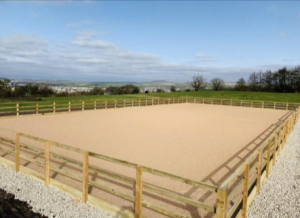 Riding arenas are the heart of equestrian activities, where horses and riders come together to train, compete, and bond. However, maintaining these arenas to ensure optimal performance is often overlooked. From ensuring proper footing to managing dust and moisture levels, arena maintenance is crucial for the safety and performance of both horse and rider. In this blog, we’ll explore the art of riding arena maintenance and how it contributes to maximizing performance.
Riding arenas are the heart of equestrian activities, where horses and riders come together to train, compete, and bond. However, maintaining these arenas to ensure optimal performance is often overlooked. From ensuring proper footing to managing dust and moisture levels, arena maintenance is crucial for the safety and performance of both horse and rider. In this blog, we’ll explore the art of riding arena maintenance and how it contributes to maximizing performance.
Understanding The Importance Of Maintenance:
A well-maintained riding arena offers numerous benefits. Firstly, proper maintenance ensures the safety of both the horse and the rider. Irregularities in footing, such as uneven surfaces or deep spots, can lead to injuries for both horse and rider. Additionally, a well-maintained arena provides consistent footing, allowing horses to perform at their best without the risk of slips or falls.
Moreover, maintaining the arena surface helps to prolong its lifespan, reducing the need for costly repairs or replacements in the long run. A properly maintained arena also enhances the overall aesthetics of the facility, creating a positive impression for riders, trainers, and visitors alike.
Footing Is Key:
One of the most critical aspects of riding arena maintenance is footing. The type and quality of footing greatly impact the performance of horses and riders. Different disciplines may require varying types of footing, such as sand, rubber, or synthetic materials. Regular grooming of the footing is essential to ensure consistency and prevent compaction, which can lead to uneven surfaces and poor drainage.
In addition to grooming, periodic testing of the footing’s moisture content and composition is crucial. This helps to maintain optimal conditions for riding, preventing issues such as dustiness or excessive moisture, which can affect traction and stability.
Dust and Moisture Management:
Dust and moisture control are also vital components of arena maintenance. Excessive dust can not only impair visibility but also pose respiratory health risks to both horses and riders. Implementing measures such as watering the arena surface or using dust control additives can help mitigate dust levels and improve air quality.
On the other hand, excessive moisture can create slick conditions, increasing the risk of slips and falls. Proper drainage systems and regular monitoring of moisture levels can help prevent these issues, ensuring a safe and comfortable riding surface in all weather conditions.
Conclusion:
In conclusion, optimizing performance in riding arenas requires careful attention to maintenance practices. From ensuring proper footing to managing dust and moisture levels, every aspect plays a crucial role in creating a safe and high-performing environment for horses and riders. At We Build Barns, we understand the importance of arena maintenance and offer comprehensive solutions to help equestrian facilities achieve optimal performance. By prioritizing arena maintenance, riders can enjoy improved safety, consistency, and longevity, ultimately enhancing their overall riding experience.
